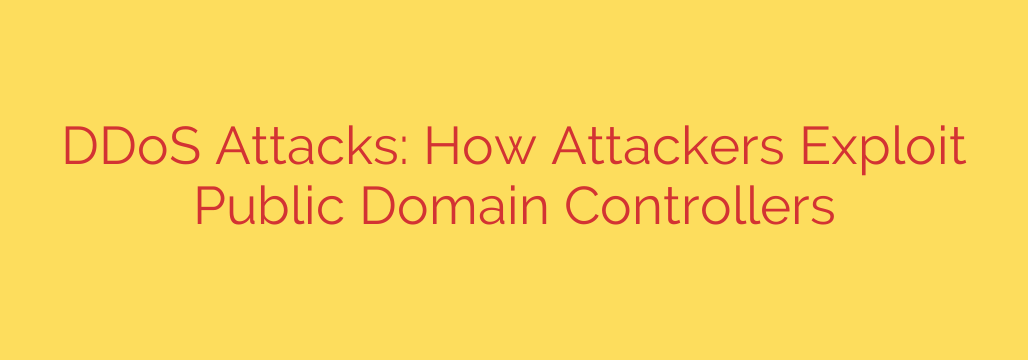
Unsecured Domain Controllers: The Hidden Threat Fueling Massive DDoS Attacks
In the ever-evolving landscape of cybersecurity, Distributed Denial of Service (DDoS) attacks remain a persistent and disruptive threat. These attacks, designed to overwhelm a target with a flood of internet traffic, can knock websites, applications, and entire networks offline. While many are familiar with common DDoS methods, attackers are increasingly exploiting a powerful and often overlooked vulnerability: publicly exposed Domain Controllers.
Understanding how this specific attack vector works is the first step toward building a more resilient defense for your organization.
Understanding DDoS Amplification Attacks
At its core, many powerful DDoS attacks rely on a technique called amplification and reflection. Here’s the simple version:
- An attacker sends a small request to a third-party server.
- Crucially, the attacker spoofs the source IP address, making it look like the request came from the intended victim.
- The third-party server, doing what it’s designed to do, sends a much larger response to the victim’s IP address.
When attackers repeat this process using thousands of servers simultaneously, they “amplify” their attack power, turning a small amount of effort into a massive, crippling flood of data aimed at their target. This is why these are also known as volumetric attacks—they aim to saturate the victim’s bandwidth completely.
What is a Domain Controller and Why is it a Target?
A Domain Controller (DC) is the gatekeeper of a Windows-based network. It’s a server running Active Directory Domain Services (AD DS) and is responsible for authenticating user identities, enforcing security policies, and managing network resources. In short, it’s one of the most critical pieces of infrastructure within a corporate network.
Under normal, secure circumstances, a Domain Controller should never be directly accessible from the public internet. Its role is strictly internal. However, due to misconfigurations, lack of security audits, or oversight, some organizations inadvertently leave their DCs exposed.
Attackers actively scan the internet for these misconfigured servers. They know that DCs are powerful, high-bandwidth machines designed to respond to requests quickly, making them perfect candidates for use in an amplification attack.
The Attack Method: Exploiting CLDAP for Massive Amplification
The primary protocol exploited in these attacks is the Connectionless Lightweight Directory Access Protocol (CLDAP), which is an alternative to the more common LDAP protocol and runs over UDP port 389. Because it’s “connectionless” (UDP), it’s easier for attackers to spoof the source IP address without the validation required by connection-oriented protocols like TCP.
Here is the step-by-step breakdown of a CLDAP reflection attack:
- Discovery: The attacker uses automated scanners to find Domain Controllers with UDP port 389 open to the public internet.
- Spoofing: The attacker crafts a small CLDAP query and sends it to the exposed DC. In the request packet, they forge the source IP address to be that of their intended victim.
- Amplification & Reflection: The DC receives the query and, believing it came from the victim, sends back a large data response. The response from a CLDAP query can be 50 to 70 times larger than the initial request, creating a massive amplification factor.
- The Flood: The attacker repeats this process with every exposed DC they can find, directing a tidal wave of amplified traffic from thousands of legitimate servers toward a single target. The victim’s network is quickly overwhelmed and forced offline.
The danger lies in the fact that the attack traffic is coming from otherwise legitimate servers. This makes it much harder to simply block a list of “bad” IP addresses, as the DCs themselves are not inherently malicious—they are simply misconfigured and being abused.
How to Protect Your Network and Prevent Abuse
Protecting your organization involves a two-pronged approach: securing your own infrastructure to prevent it from being used in an attack, and defending your network from being targeted.
If you manage a network with Domain Controllers:
- Audit Your Perimeter: The most important step is to ensure your Domain Controllers are not exposed to the internet. Use external port scanning tools to check your public IP addresses for open ports, especially UDP port 389.
- Implement Strict Firewall Rules: Configure your firewalls to block all incoming traffic to your Domain Controllers from the public internet. Access to DCs should be limited to the internal network only.
- Use Network Segmentation: Isolate critical servers like DCs on their own network segments with strict access control lists (ACLs), limiting which parts of the network can communicate with them.
- Disable Unused Services: If a service isn’t essential for business operations, it should be disabled to reduce your attack surface.
To defend against incoming DDoS attacks:
- Invest in DDoS Mitigation Services: For any business that relies on internet uptime, a professional DDoS mitigation service is essential. These services can detect and filter malicious traffic floods before they ever reach your network.
- Work with Your ISP: Many internet service providers offer basic DDoS protection services that can help absorb smaller-scale attacks.
- Implement Ingress Filtering: Network administrators can help the entire internet ecosystem by implementing ingress filtering (as outlined in BCP 38), which prevents traffic with spoofed IP addresses from leaving their network.
By understanding this dangerous attack vector and taking proactive steps to secure your critical infrastructure, you can not only protect your own organization but also help make the internet a safer place for everyone.
Source: https://www.helpnetsecurity.com/2025/08/11/win-ddos-domain-controllers-ddos-vulnerability-cve-2025-32724/








